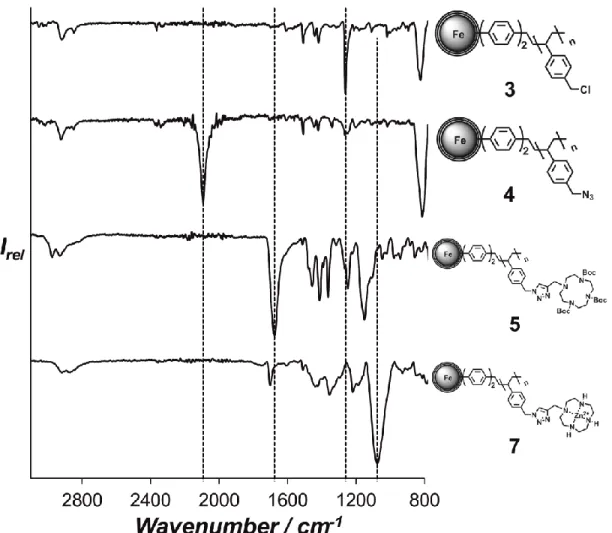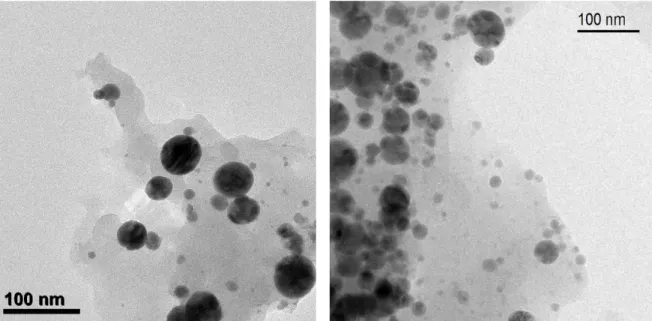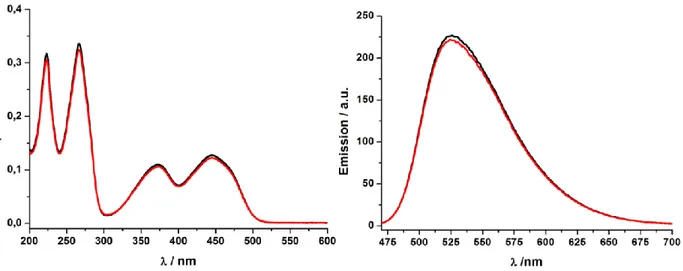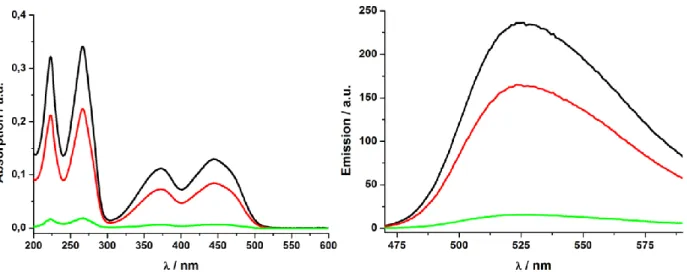Magnetic Nanobeads as Support for Zinc(II)–Cyclen
Complexes: Selective and Reversible Extraction of Riboflavin
iQuirin M. Kainz, Andreas Späth, Stefan Weiss, Alexander Schätz, Wendelin J. Stark, Burkhard König, and Oliver Reiser*
Supporting Information
1. NMR spectra S2
2. IR-ATR spectra S3
3. TEM pictures S4
4. Additional UV- and fluorescence-spectra, binding studies S4
i Reproduced with permission from: Q. M. Kainz, A. Späth, S. Weiss, A. Schätz, W. J. Stark, B. König, O. Reiser, ChemistryOpen 2012, 1, 125–129. Copyright 2012 The Authors.
S2
1. NMR spectra
2
1H-NMR
(300 MHz, CDCl3)
13C-NMR
(75.5 MHz, CDCl3)
2
S3
2. IR-ATR spectra
Figure S1. IR Spectra depicting the nucleophilic substitution of the benzyl chloride moieties in 3 with sodium azide and the subsequent attachment of the cyclen ligand followed by complexation with Zn(II).
S4
3. TEM pictures
Figure S2. TEM pictures of polymer-encapsulated Fe/C nanoparticles before the functionalization with zinc(II)-cyclen complexes (3, left) and after the functionalization (7, right).
No substantial changes between the pictures are noticeable.
4. Additional UV- and fluorescence-spectra, binding studies
Figure S3. Absorption- (left) and emission- (right) measurements to determine the loading of the functionalized particles. Solution of riboflavin (30 μm, —), solution after treatment with 7 (—), and recovery of riboflavin from 7 (—). 200 mL of a riboflavin solution (30 µM) and 20 mg of 7 were used. To recover the riboflavin the particles were washed with 100 ml diluted HCl. From the differences in the intensities a loading of ~ 0.16 mmol/g was calculated.
S5
Figure S4. Absorption- (left) and emission- (right) measurement of the polymer coated particles 3 lacking the zinc(II)-cyclen complexes. The solution of riboflavin (10 μm, —) and the solution after treatment with 3 (—) is depicted. Only a negligible amount of riboflavin is adsorbed by the particles.
Figure S5. Binding- and release of riboflavin to Zn(II)-cyclen-functionalized Co/C nanoparticles 13. Absorption spectra (left) as well as emission spectra (right) are shown. Solution of riboflavin (10 μm, —), solution after treatment with 13 (—), and recovery of riboflavin from 13 (—).
S6
Figure S6. Absorption- (left) and emission- (right) measurement of non-functionalized Co/C particles. Solution of riboflavin (10 μm, —), solution after treatment with particles (—), and recovery of riboflavin (—). The addition of riboflavin onto the nanoparticle surface is observed to some extent, which cannot be reversed.
Figure S7. Absorption- (left) and emission- (right) measurements of a riboflavin solution stirred with Zn(II)-biscyclen functionalized nanobeads 18. Solution of riboflavin (10 μm, —), solution after treatment with 18 (—), and recovery of riboflavin from 18 (—). The biscyclen-tagged particles do reversibly adsorb riboflavin, however, at a reduced efficiency.



